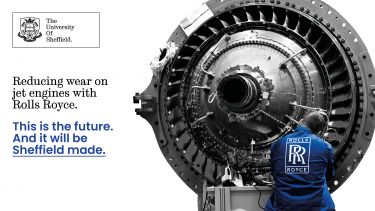At the cutting edge of Rolls-Royce aero-engines
Tribology research at Sheffield has pioneered a new era of understanding regarding the wear mechanics associated with sealing in aero-engines.

Our research collaboration with Rolls-Royce has provided significant cost savings and reduced CO2 emissions through solving business critical engine wear issues experienced on their Trent 1000 engines.
Over the last 40 years, aero-engine manufacturers have focused on improving sealing, and ultimately engine performance, by using abradable linings on the inner wall of the engine casing to maximise sealing and minimise wear of the fast-moving blade tips.
Historically, abradable lining research has required the construction of full-scale test rigs, typically using scrap aero-engine compressor units, which are costly. The nature and complexity of the test setup means that the instrumentation is unique, and repeatability is difficult to obtain. The test conditions mean that it is impossible to fully explore the deterioration of abradable lining material or generate an understanding of the underlying wear processes.
This led to Professor Matthew Marshall and the Leonardo Tribology Centre recognising the need for a suitable in-situ test platform. The challenge was to create a test environment that could reliably and repeatedly induce the wear mechanisms occurring in an aero-engine and integrate suitable instrumentation to investigate the fundamental mechanics of the abrasion process.
Unplanned maintenance of aero-engines, due to parts wearing out faster than expected, incur enormous costs and service disruption for both manufacturers and operators.
Ultimately, Sheffield’s research has enabled us to realise huge economic savings, enabling planes to quickly return to service, and surmounting serious aero-engine challenges. It has directly resulted in knowledge enhancement and new capabilities throughout the organisation, and ultimately boosted the service that we provide to airlines, which has consolidated our reputation and market position
The Rolls-Royce Chief of Technology and Digital – Fans and Compressors
Furthermore, Sheffield’s research into understanding the material wear mechanisms at the blade tip seal interface has directly improved overall engine performance. The Chief of Technology and Digital added: “the research has directly enabled reduced fuel burn and emissions”.
These improvements in aero-engine fuel consumption inherently led to reduced CO2 emissions. Uptake of Sheffield’s research by Rolls-Royce and application to the Trent 1000 engines, used within the Boeing 787 Dreamliner, has supported their achievement of an overall 20% improvement in fuel use compared to other similarly sized aeroplanes.
